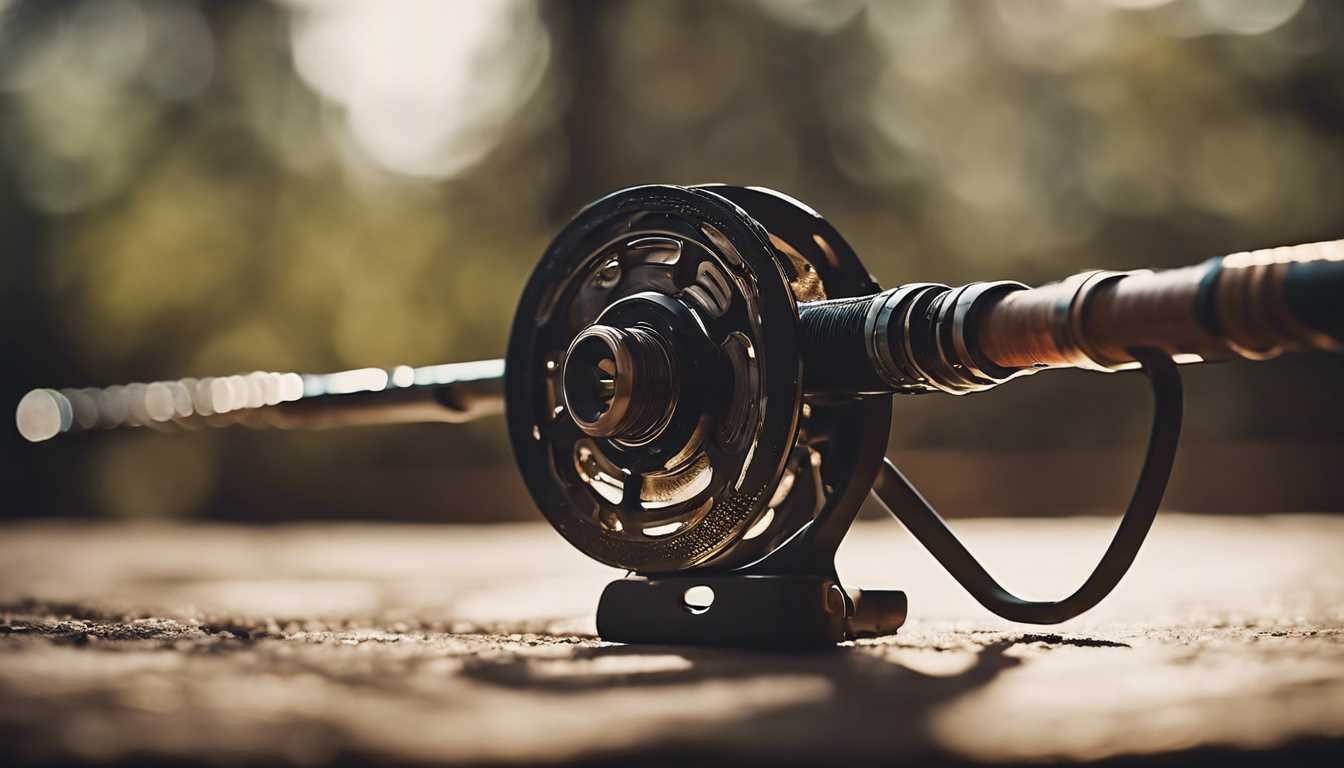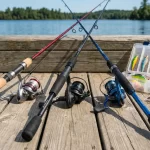You’re not alone if you’ve ever stood in the fishing aisle staring blankly at the endless array of fishing rods. I’ve been there too—overwhelmed by choices and wondering what makes one rod different from another.
After years of experience and countless fishing trips, I’ve learned that one of the most critical factors in a rod’s performance comes down to what it’s made of. The materials used in your fishing rod significantly impact everything from sensitivity to durability, weight, and price.
In this guide, I’ll break down the different types of fishing rod materials, explain their pros and cons, and help you understand exactly which material might be best for your specific fishing needs. Whether you’re chasing bass in freshwater or battling marlins offshore, the right rod material can make all the difference.
The Evolution of Fishing Rod Materials
Fishing rods have come a long way from their humble beginnings. The original fishing rod materials were primarily natural substances like wood, bamboo, and reed. While these traditional materials served anglers well for centuries, modern technology has introduced materials that offer incredible performance advantages.
Today’s fishing rods are engineering marvels, utilizing advanced materials science to create tools that are lighter, stronger, and more sensitive than anything our fishing ancestors could have imagined. Let’s explore the journey from simple sticks to high-tech fishing instruments.
Traditional Fishing Rod Materials
Bamboo: The Classic Choice
Bamboo has been used for fishing rods for thousands of years, and good reason. This natural material offers an excellent combination of strength, flexibility, and lightness that made it the gold standard for fishing rods until relatively recently.
Bamboo rods, particularly split-cane models, are still prized by traditionalists and fly anglers who appreciate their smooth-loading action and natural feel. Each bamboo rod is a work of art, requiring skilled craftsmanship to split, plane, and glue strips of bamboo into a hexagonal cross-section.
The advantages of bamboo include:
- Natural, progressive flex
- Beautiful aesthetics
- Excellent durability when properly cared for
- A distinctive “feel” that many anglers love
However, bamboo does have some significant drawbacks:
- Heavier than modern materials
- More expensive due to labor-intensive construction
- Requires more maintenance and care
- Can warp if exposed to excessive heat or moisture
Wood: Where It All Began
Before bamboo became widespread, simple wooden poles served as the original fishing rod material. Various hardwoods were used, often with the bark stripped away and the tip tapered for better action.
While pure wooden rods are rare today outside of primitive fishing or survival situations, wood still plays a role in some aspects of fishing rod building materials, particularly in handles and decorative components.
If you’re wondering how to make a fishing rod in nature, wood remains your best option. A straight, flexible sapling or branch can be fashioned into a functional fishing pole with minimal tools, just like our ancestors did.
Modern Fishing Rod Materials
Fiberglass: The Durable Workhorse
Fiberglass revolutionized the fishing industry when it was introduced in the 1940s and became the dominant rod material through the 1970s. While it has since been surpassed in popularity by graphite for many applications, fiberglass remains an excellent choice for specific fishing scenarios.
Fiberglass fishing rods are made by embedding glass fibers in a resin matrix. This creates a material that is:
- Exceptionally durable and difficult to break
- Highly flexible with a slow, parabolic action
- Relatively inexpensive compared to other materials
- Low-maintenance and resistant to environmental factors
The main drawbacks of fiberglass include:
- Heavier than graphite or carbon fiber
- Less sensitive for detecting subtle bites
- Slower action, which can be a disadvantage for some techniques
Fiberglass excels for crankbait fishing, where its slow, forgiving action helps prevent fish from throwing hooks. It’s also fantastic for beginners and children since it can withstand rough handling. Many anglers consider fiberglass to be the most forgiving of all fishing rod material types.
Graphite/Carbon Fiber: The Sensitive Performer
When people ask me what is the best material for a fishing rod for modern fishing, graphite or carbon fiber is often my answer. First introduced in the 1970s, graphite quickly became the material of choice for serious anglers due to its incredible sensitivity and lightweight properties.
Graphite rods are rated by “modulus”—a measure of stiffness. Higher modulus graphite creates stiffer, lighter rods, but at the cost of durability:
- IM6 (Intermediate Modulus): Good balance of strength and sensitivity
- IM7/IM8: Higher performance with increased stiffness
- High Modulus (HM): Ultra-sensitive but more brittle
The benefits of graphite fishing rods include:
- Exceptional sensitivity for detecting subtle bites
- Lightweight design that reduces fatigue during long fishing sessions
- Fast action for solid hooksets
- Available in various power ratings for different applications
The downsides are:
- More brittle than fiberglass and prone to breaking if mishandled
- Generally more expensive
- Can be too sensitive for beginners who haven’t developed touch
I’ve found graphite to be ideal for techniques where sensitivity is paramount, such as finesse fishing, jigging, and drop-shotting. If you need to feel every pebble on the bottom or the slightest tap from a fish, graphite is your friend.
Composite Rods: The Best of Both Worlds
For anglers who can’t decide between the durability of fiberglass and the sensitivity of graphite, composite rods offer an excellent compromise. These rods use a blend of materials to create blanks with characteristics that neither material could achieve alone.
A typical composite might combine:
- Graphite for the backbone and sensitivity
- Fiberglass for durability and flex characteristics
- Sometimes, additional materials like basalt or boron for specific properties
The advantages of composite rods include:
- More durable than pure graphite
- More sensitive than pure fiberglass
- Customized actions for specific techniques
- Good value for the performance
When to consider a composite rod:
- When fishing techniques that benefit from both sensitivity and forgiveness
- If you’re hard on equipment but don’t want to sacrifice performance
- For versatile all-around rods that can handle multiple techniques
I’ve personally found composite rods to be excellent choices for crankbait fishing, where you need some backbone for casting distance but also want the forgiving action of fiberglass to keep fish pinned.
Specialized Materials in Modern Rod Construction
Boron: The Strength Enhancer
Boron is sometimes added to high-end rods to increase strength without adding significant weight. This material is typically used in small amounts at strategic points in the blank to reinforce areas prone to stress without compromising the rod’s action.
S-Glass: Advanced Fiberglass
S-Glass is an advanced form of fiberglass that offers greater strength and reduced weight compared to traditional E-Glass fiberglass. It bridges the gap between standard fiberglass and graphite, providing enhanced performance while maintaining excellent durability.
Nano Resin and Nano Silica
Some manufacturers incorporate nano-technology into their resin systems. These microscopic particles help fill gaps between carbon fibers, creating stronger connections and reducing weight while enhancing sensitivity.
How Rod Materials Affect Performance
Click on each performance factor to see how different materials compare. Hover over material names for more details.
⏚ Sensitivity ▼
Sensitivity refers to how well the rod transmits vibrations from the line to your hand. This is crucial for detecting subtle bites and feeling structure on the bottom.
Best for: Finesse techniques or targeting light-biting species
⚖ Weight ▶
↜ Action & Power ▶
🛡 Durability ▶
Matching Rod Materials to Fishing Styles
Bass Fishing
For bass fishing, your rod material should match your technique:
- Jigs and Texas rigs: High-modulus graphite for sensitivity
- Crankbaits: Fiberglass or composite for forgiveness
- Topwater: Mid-modulus graphite for hooksets
- Finesse techniques: Highest modulus graphite available
Trout and Panfish
When targeting smaller species:
- Ultra-light spinning: Mid-modulus graphite for sensitivity with some forgiveness
- Stream fishing: Composite for durability when navigating brushy areas
Fly Fishing
Fly fishing rod materials have unique considerations:
- Bamboo: Traditional feel, slow action, heavy but beautiful
- Fiberglass: Smooth casting, excellent for small streams and dry flies
- Graphite: Fast action, lightweight for distance casting
- Composite: Versatile performance across different fly fishing scenarios
Saltwater Fishing
The harsh saltwater environment demands specific materials:
- Inshore: High-quality graphite or composite for sensitivity and durability
- Offshore: Heavy-duty composite or fiberglass for fighting powerful fish
The Cost Factor: Material Price Comparison
Your budget will inevitably influence your rod material choice. Here’s a general price hierarchy from most to least expensive:
- High-end bamboo (handcrafted): 1,000−5,000+
- High-modulus graphite: 200−800
- Mid-modulus graphite: 100−300
- Composite: 80−300
- S-Glass: 80−250
- Standard fiberglass: 40−150
Remember that price doesn’t always correlate directly with performance for your specific needs. A 100fiberglassrodmightoutperforma300 graphite rod for certain techniques.
Rod Building: Choosing Materials for Custom Rods
If you’re interested in building your custom rod, understanding fishing rod-making materials becomes even more important.
The key components include:
- Rod blank: The core of the rod, made from your chosen material
- Guides: Ceramic or stainless steel rings that guide the line
- Handle: Cork, EVA foam, or hybrid materials
- Reel seat: Aluminum, graphite, or wood construction
Custom rod building allows you to select the perfect combination of materials for your specific fishing needs, creating a truly personalized tool.
When selecting materials needed to make a fishing rod, consider:
- Blank material appropriate for your target species and technique
- Guide quality (poor guides can damage line and reduce casting distance)
- Handle material that feels comfortable in your hand
Maintaining Different Rod Materials
Different rod materials require different care approaches:
Graphite Rods
- Avoid impact against hard surfaces that can cause microfractures
- Store vertically or horizontally, supported along the entire length
- Clean with mild soap and water, avoid harsh chemicals
Fiberglass Rods
- More forgiving of rough handling, but still clean after saltwater use
- Check for separation of fibers or “starring” that indicates damage
- Can withstand more temperature variation than graphite
Bamboo Rods
- Require the most careful maintenance
- Apply a light coat of wax or oil periodically
- Store in cloth sleeves in a climate-controlled environment
- Keep away from excessive moisture and heat
The Future of Fishing Rod Materials
The fishing rod industry continues to innovate with new materials and construction techniques. Some emerging trends include:
- Nano-carbon technology for enhanced strength-to-weight ratios
- Eco-friendly bio-composite materials that reduce environmental impact
- Computer-designed tapers that maximize performance characteristics
- Hybrid construction methods that utilize multiple materials in specific rod sections
These advancements promise to deliver even better performance while potentially reducing costs and environmental impact.
Making Your Final Decision
With all this information about different fishing rod materials, how do you make your final choice? Here’s my process:
- Consider your primary fishing technique and species
- Determine which performance characteristics matter most (sensitivity, durability, action, weight)
- Set your budget
- If possible, test different materials before buying
- Research specific models that use your preferred material
Remember that there’s no single “best” material—only the material that’s best for your specific fishing style, budget, and preferences.
Conclusion
Choosing the right fishing rod material doesn’t have to be overwhelming. By understanding the strengths and weaknesses of different types of fishing rod materials, you can make an informed decision that enhances your fishing experience.
I hope this guide has helped demystify the world of fishing rod materials and given you the confidence to select the perfect rod for your next fishing adventure. Remember, the best rod is the one that feels right in your hands and matches your fishing style, regardless of what material it’s made from.
What’s your experience with different rod materials? Do you have a preference for certain techniques? I’d love to hear your thoughts in the comments below!
FAQs About Fishing Rod Materials
What is the most durable fishing rod material?
Fiberglass is generally considered the most durable fishing rod material. It can withstand impacts, bending, and environmental stress better than graphite or bamboo. If durability is your primary concern, especially for situations where your rod might take a beating (like fishing around rocks or teaching children), fiberglass is the way to go. S-Glass, an advanced form of fiberglass, offers improved durability while reducing some of the weight disadvantages of traditional fiberglass.
How do I know if my graphite fishing rod is damaged?
Graphite fishing rods can develop invisible microfractures that weaken the blank. Signs of damage include: visible cracks or splits in the blank; a change in action (the rod feels “dead” or bends differently); unusual flexing when under load; or a scraping/crunching feeling or sound when bending the rod. If you suspect your graphite rod is damaged, perform a gentle flex test away from your face and listen for unusual sounds. When in doubt, have it inspected by a professional, as fishing with a damaged graphite rod can lead to catastrophic failure when fighting a fish.
Are expensive rod materials worth the extra cost?
The value of high-end rod materials depends on your fishing style and level of experience. For professionals or serious anglers who can detect subtle differences in performance, premium materials may provide a meaningful advantage. The extra sensitivity of high-modulus graphite can help detect light bites, while the reduced weight may prevent fatigue during long fishing sessions. However, for casual anglers or beginners, mid-range materials often provide excellent performance at a more reasonable price point. Consider your budget and how frequently you fish before investing in top-tier materials.
Can I make a functional fishing rod from materials found in nature?
Yes, you can create a simple but functional fishing rod using natural materials. The most common approach is to find a straight, flexible sapling or branch (hazel, willow, or bamboo work well) that’s approximately 6-10 feet long. Remove any small branches and carefully taper the tip for better action. You can attach line directly to the tip or fashion simple guides using small loops of cordage. While these natural rods won’t have the performance characteristics of modern materials, they’ve successfully caught fish for thousands of years and are excellent for survival situations or teaching traditional skills.
How do rod materials affect casting distance?
Rod materials significantly impact casting distance through their combination of weight, stiffness, and flex patterns. Graphite rods, being lighter and typically faster action, allow for quicker loading and release of energy, which can translate to longer casts with lighter lures. Fiberglass rods, with their slower action, may launch heavier lures further due to their deeper loading capability. Composite rods offer a balance of these properties. The optimal material for maximum casting distance depends on your casting style, lure weight, and fishing conditions. Generally, matched properly with the right lure weight, high-quality graphite will provide the best casting distance for most anglers.








